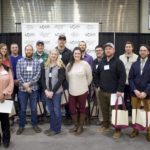Pumpkins/Squash
Plectosporium blight in some pumpkin fields seen again this year
I am seeing some plectosporium blight in a few pumpkin fields this year, not as bad as last year but still there. This disease will probably increase if we continue having frequent rains in some... more »
Be on the lookout for fusarium fruit rot, other threats in the mid-Atlantic
There continue to be no reports of late blight on tomato or potato in the mid-Atlantic region. But, this week there was a confirmed report on tomato in eastern Tennessee determined to be caused by... more »
Ampersand adjuvant approved for use with fungicides in California
Attune Agriculture, the leader in developing performance based agricultural products using hydrocolloid technology, announced Aug. 5 that Ampersand adjuvant is now approved for use with fungicides in California. Ampersand is now officially approved for use... more »
Quality problems in fruiting vegetables reported in Delaware
We are seeing quality problems in many fruiting vegetables in the Delaware region. Often this is due to poor pollination. Signs of incomplete pollination in cucurbits include bottlenecked fruit or fruit with a pinched end,... more »
Spotted cucumber beetle management urged in Illinois
There seems to be a larger number of striped and spotted cucumber beetles this year in Illinois compared to previous years. It is important to control these beetles as they transmit the pathogen that causes... more »
Proper steps identified to control pumpkin disease
I was recently asked about disease control programs for pumpkins. The following was modified from an article by Kate Everts in 2019 that I have added updated fungicide recommendations and additional information about certain diseases.... more »
Linear bed foot method determines fertilizer needs for plastic mulch crops
In the Mid-Atlantic Commercial Vegetable Production Recommendations, fertilizer recommendations are given on a per acre basis. For crops grown on plastic mulch, the most common bed spacing between rows is used and recommendations are based... more »
All hands needed to protect wild bee pollinators
Wild and honeybees pollinate many of the crops we eat. Each farmer’s field is part of a larger agricultural landscape where bees forage and collect nectar throughout the area, potentially visiting a variety of crops.... more »
















